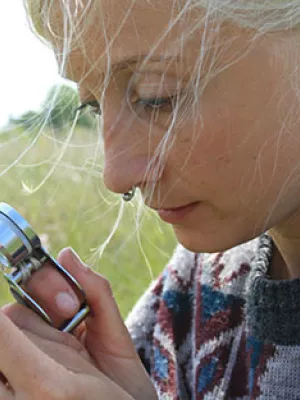
Lina Herbertsson
Researcher

Pollinators and Insect Pollination in Changing Agricultural Landscapes
Author
Summary, in English
pollinator species. One study was performed by compiling data from several native plant species across Europe. For three additional studies, I collected field data. I found that a lack of landscape heterogeneity can reduce the number of flowervisiting pollinators in European semi-natural habitats (including semi-natural grasslands and semi-open bushlands) and result in competition for floral resources between managed honey bees and wild bumble bees. There was no general effect of landscape heterogeneity on the reproductive success of insect-pollinated plants in European agricultural landscapes. Instead, the field studies suggested that landscape heterogeneity modifies the impact of other factors. For example, the cultivation of oilseed rape benefitted the reproductive success of one later-flowering study species, but not another, and only in landscapes with low heterogeneity. Also, sown flower strips, which are used to supply pollinators with floral resources, benefitted the reproductive success of adjacent plants in landscapes with low heterogeneity, but had a negative impact on the reproductive success of adjacent plants in more heterogeneous landscapes. As many previous studies, this thesis highlights the importance of preserving landscape heterogeneity and semi-natural grasslands in order to protect viable pollinators populations. Although I found no general impact of landscape heterogeneity on plant reproductive success, the persistence of insect-pollinated plants will largely depend on pollinator availability, and thereby on maintained semi-natural grasslands. The maintenance of semi-natural grasslands and landscape heterogeneity in general are important for wild pollinators and can reduce the negative consequences on their populations from competition with managed honey bees. The restoration and maintenance of these habitats may be particularly important in heterogeneous landscapes, where they are particularly species rich and the opportunity cost for the farmers is lower than in homogeneous landscapes. In homogeneous landscapes, where semi-natural grasslands are scarce and more difficult to maintain because of a lack of animal husbandry and a high opportunity cost, sown flower strips can be used to benefit common ecosystem service providing organisms and to some extent the pollination of wild plants.
Department/s
- BECC: Biodiversity and Ecosystem services in a Changing Climate
- Centre for Environmental and Climate Science (CEC)
- Environmental Science
Publishing year
2017-10
Language
English
Document type
Dissertation
Publisher
Lund University, Faculty of Science, Centre for Environmental and Climate Research
Topic
- Environmental Sciences
Keywords
- pollinators
- pollination
- agri-environment schemes
- beekeeping
- oilseed rape
- sown flower strips
- agri-environment measures
Status
Published
Supervisor
- Henrik G. Smith
- Maj Rundlöf
- Johan Ekroos
- Riccardo Bommarco
ISBN/ISSN/Other
- ISBN: 978-91-7753-478-5
- ISBN: 978-91-7753-477-8
Defence date
17 November 2017
Defence time
10:00
Defence place
Lecture hall “Blå hallen”, Ecology building, Sölvegatan 37, Lund
Opponent
- Ben Woodcock (Dr.)